Birds are an essential part of the ecosystem in Humboldt Bay. This coastal lagoon, located on the northern coast of California, is home to a diverse range of bird species throughout the year.
With its rich array of habitats, including marshlands, mudflats, and rocky shores, the bay provides a critical migratory stopover point for many bird species during their long journeys along the Pacific Flyway.
In addition to providing vital feeding and breeding grounds, Humboldt Bay also plays a crucial role in the conservation of several endangered bird species, such as the Aleutian cackling goose and the marbled murrelet.
Let us delve deeper into the fascinating world of birds in Humboldt Bay and learn about their unique behaviors, habits, and adaptations to this dynamic coastal environment.
1. Black-Capped Chickadee

The black-capped chickadee is a small and cheerful songbird found in deciduous and mixed forests across North America. It has an iconic black cap, white cheeks, gray back and wings with whitish bars on them.
The underparts are usually light colored or greyish brown. This species is well adapted to cold winters as it can reduce its body temperature by up to 8°C while roosting at night; this helps save energy during the colder months of the year.
It feeds mainly on insects but also eats seeds, fruits and suet from bird feeders when available.
Black-capped chickadees are popular birds among backyard visitors due to their sociable nature – they often establish lifelong partnerships with one another for breeding purposes.
Furthermore, they have been designated as state birds of Massachusetts and Maine in USA plus New Brunswick in Canada – a testament to how beloved these little avian friends truly are.Scientific classification:
| Kingdom | Animalia |
| Phylum | Chordata |
| Class | Aves |
| Order | Passeriformes |
| Family | Paridae |
| Genus | Poecile |
| Species | P. atricapillus |
Also Featured In: Most Common United States Birds, Most Common Winter Birds
2. California Quail
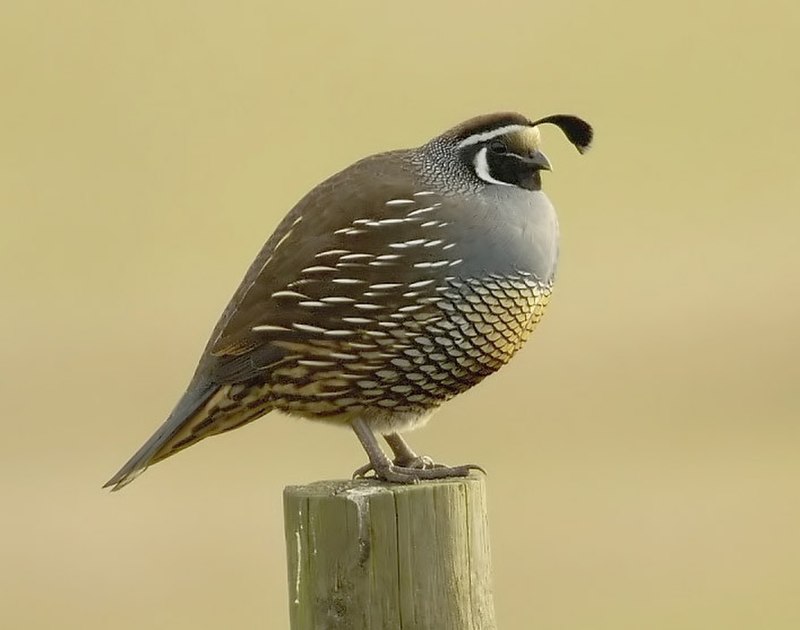
The California quail is a small, ground-dwelling bird with an iconic drooping crest. Male birds have a dark brown cap and black face while females sport a brown back and white streaks on their flanks.
These quails are found in the western United States and parts of northern Mexico and may gather in groups to feed or dust bathe together during the day.
Their diet consists mainly of grasses, seeds, berries as well as some insects like beetles or ants.
The population has been declining due to habitat loss so conservation efforts are being implemented for this species’ survival.Scientific classification:
| Kingdom | Animalia |
| Phylum | Chordata |
| Class | Aves |
| Order | Galliformes |
| Family | Odontophoridae |
| Genus | Callipepla |
| Species | C. californica |
Also Featured In: Hawaii Big Island Birds You Should Know, Small Birds of California
3. American Avocet
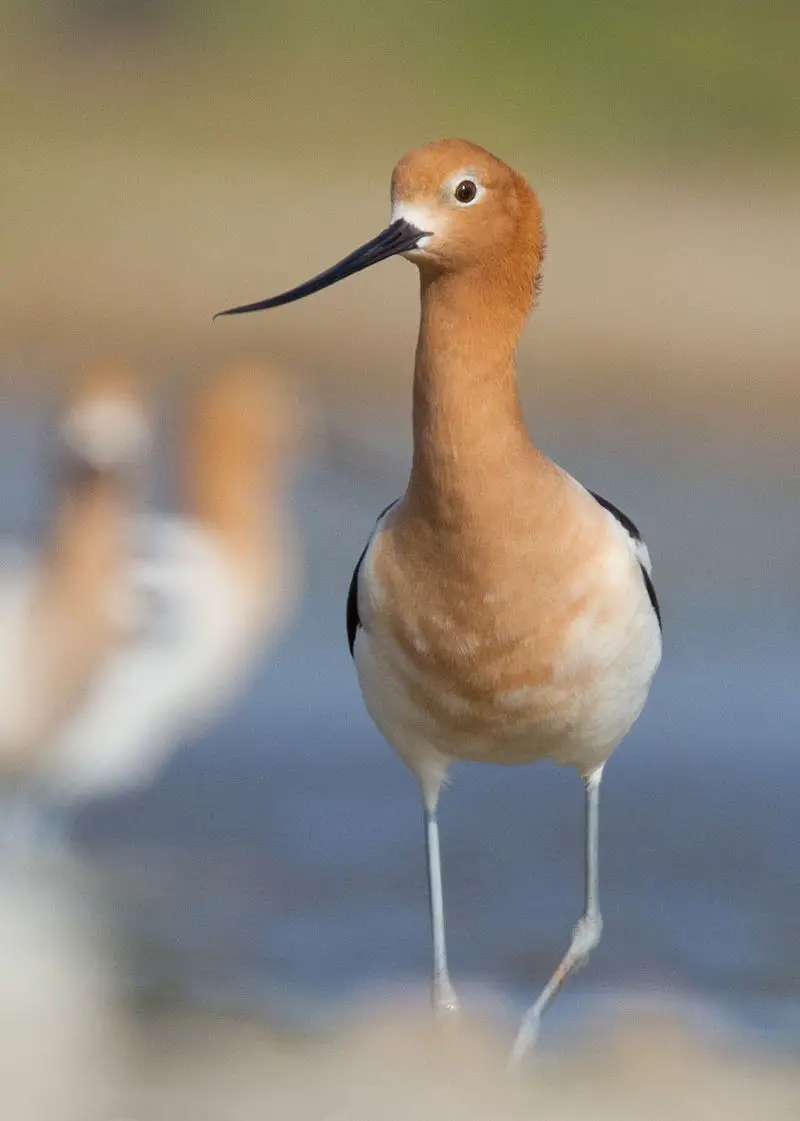
The American avocet is a stunningly beautiful bird found in North America. With its striking black and white plumage, long blue legs, and upturned bill it is an unmistakable sight.
It spends much of its time foraging around shallow water or mud flats searching for crustaceans and insects to feed on by sweeping its beak from side-to-side through the water.
The German naturalist Johann Friedr formally described this species back in 1789 as Recurvirostra americana – aptly named due to their habit of recurving their bills when feeding.
These graceful wading birds are truly a marvel of nature that deserve our admiration.Scientific classification:
| Kingdom | Animalia |
| Phylum | Chordata |
| Class | Aves |
| Order | Charadriiformes |
| Family | Recurvirostridae |
| Genus | Recurvirostra |
| Species | R. americana |
Also Featured In: Most Popular Bird Species in North America, Birds that Live around Central Florida
4. Canada Goose
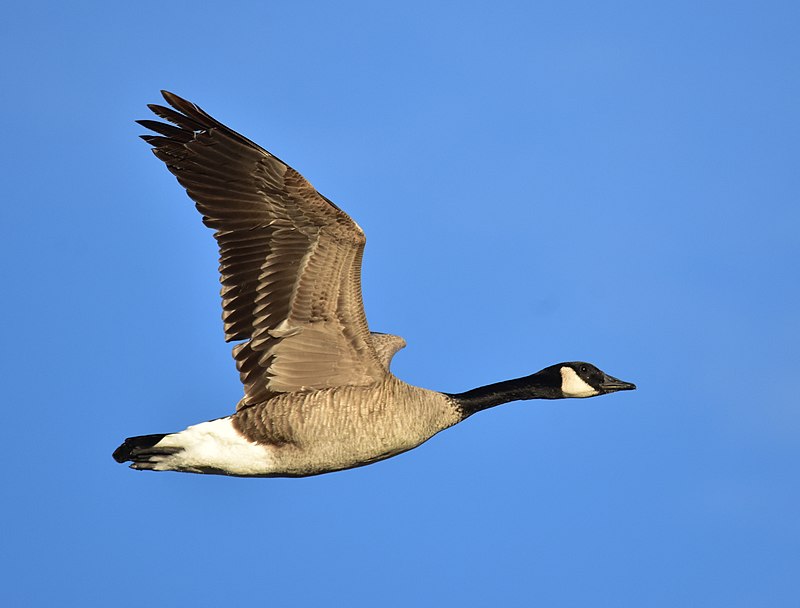
The Canada goose is a majestic bird with a black head and neck, white cheeks, chin and brown body. It’s native to North America but occasionally migrates to northern Europe across the Atlantic.
The species has been introduced in the United Kingdom, Ireland and Finland as well. Canada geese are strong flyers that travel in flocks for protection from predators; they also form monogamous pairs for life.
They feed on grasses or grains near ponds or wetlands where they make their nests of down which incubate eggs during summertime before hatching them out into goslings later on.Scientific classification:
| Kingdom | Animalia |
| Phylum | Chordata |
| Class | Aves |
| Order | Anseriformes |
| Family | Anatidae |
| Genus | Branta |
| Species | B. canadensis |
Also Featured In: Water Birds Live around Us, Birds Live in Arkansas
5. Dunlin
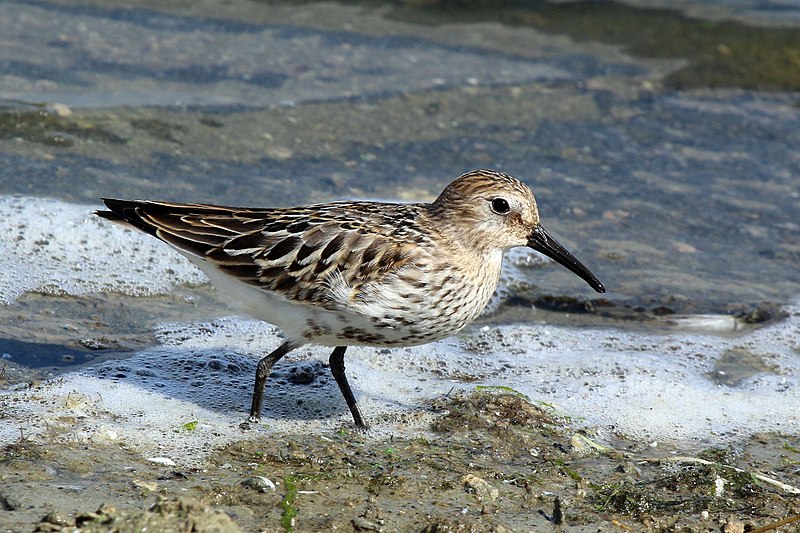
The Dunlin is a small wader, formerly known as part of the stint family. It has dull brown feathers and its name is derived from the dialect word “dunling”.
This bird breeds in Arctic or subarctic regions during summer months, but migrates to warmer climates during winter.
The Dunlin feeds on insects and invertebrates which it finds in mudflats and shallow waters.
During breeding season they form large flocks that can contain thousands of birds. They are also well-known for their impressive synchronized flight patterns that look like a wave moving through the sky.Scientific classification:
| Kingdom | Animalia |
| Phylum | Chordata |
| Class | Aves |
| Order | Charadriiformes |
| Family | Scolopacidae |
| Genus | Calidris |
| Species | C. alpina |
Also Featured In: Flight Birds You Should Know, Shetland Islands Birds You Should Know
6. Marbled Godwit
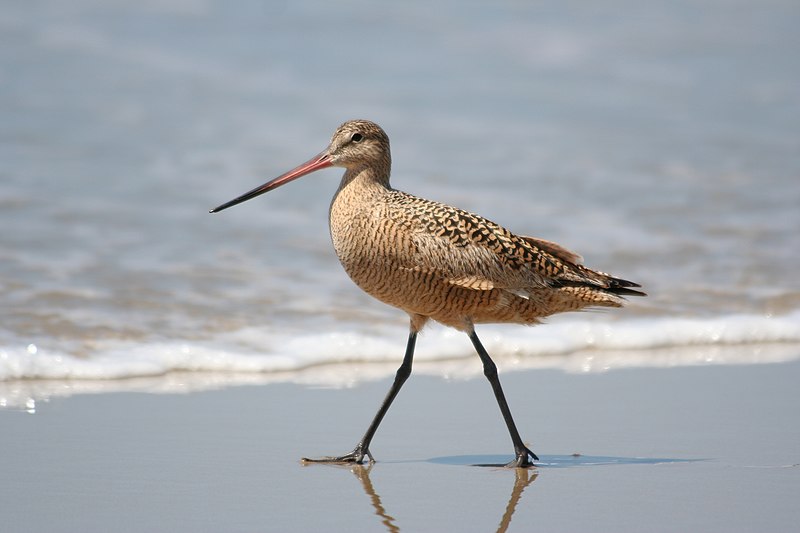
The Marbled Godwit is a large migratory shorebird in the Scolopacidae family and is one of the largest species amongst four godwits.
It was first described by English naturalist George Edwards in 1750, as ‘The Greater American Godwit’.
The bird has long legs and bill for probing mudflats for food. Their plumage varies from mottled gray to reddish or brown on their upperparts, with white underparts that contrast against it.
During breeding season they can be seen along northern prairies in North America and migrate south towards Mexico during winter months.
They are omnivorous feeders but prefer aquatic insects like crustaceans, larvae etc., which makes them an important element of wetland ecosystems across its range.Scientific classification:
| Kingdom | Animalia |
| Phylum | Chordata |
| Class | Aves |
| Order | Charadriiformes |
| Family | Scolopacidae |
| Genus | Limosa |
| Species | L. fedoa |
Also Featured In: Top Birds Found in Mexico, Wetlands Birds You Should Know
7. Pelagic Cormorant
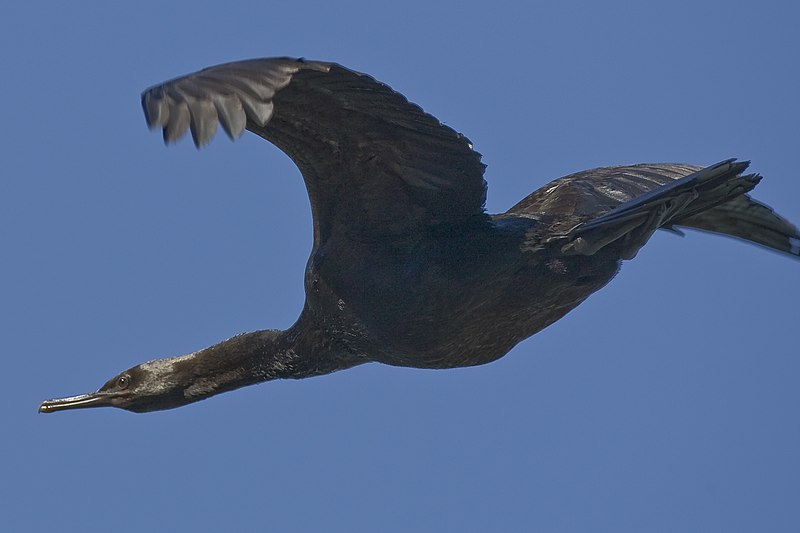
The pelagic cormorant, also known as Baird’s cormorant or violet-green cormorant, is a small member of the Phalacrocoracidae family and is often referred to as the Pelagic Shag.
It inhabits coastal areas and open oceans throughout Northern Pacific regions. These birds are relatively small in size with a dark greyish body and bright blue eyes which can be seen from far away distances.
Their wingspan extends up to two feet wide allowing them to glide through air currents at rapid speeds while they hunt fish for food.
They have an impressive diving ability that allows them to plunge underwater depths reaching 30 meters deep.
The pelagic cormorants are quite social creatures who live together in large flocks during both summer and winter months providing safety in numbers when hunting prey beneath the waves of their ocean home.Scientific classification:
| Kingdom | Animalia |
| Phylum | Chordata |
| Class | Aves |
| Order | Suliformes |
| Family | Phalacrocoracidae |
| Genus | Urile |
| Species | U. pelagicus |
Also Featured In: Native South Korean Birds, Birds that Live in Vancouver
8. Eurasian Whimbrel
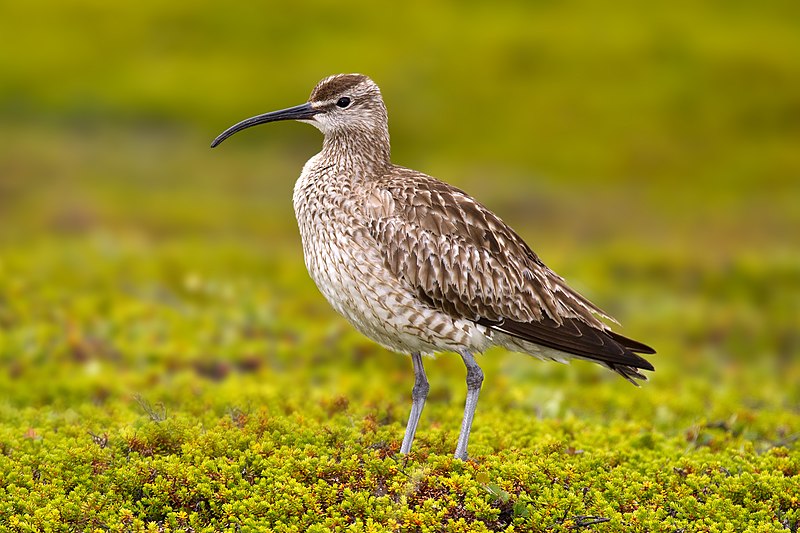
Eurasian Whimbrels are a species of wading bird commonly found in subarctic regions of Europe and Asia.
They have white rumps, long curved bills, brown wings and backs with light streaking on the lower breast.
These birds feed mainly on crustaceans, mollusks or worms they find while probing in the mud during low tide.
During breeding season they can be seen nesting near coastal areas or wetlands where food is plentiful.
This species has recently been split from Hudsonian whimbrels but some authorities still consider them to be one species due to their similarities which includes migration patterns as well as habitat preferences.
Eurasian whimbrels are an important part of many ecosystems because they help control insect populations by eating larvae before it can cause damage to crops or vegetation nearby.Scientific classification:
| Kingdom | Animalia |
| Phylum | Chordata |
| Class | Aves |
| Order | Charadriiformes |
| Family | Scolopacidae |
| Genus | Numenius |
| Species | N. phaeopus |
Also Featured In: Singapore Birds, Galapagos Birds You Should Know
9. Brant
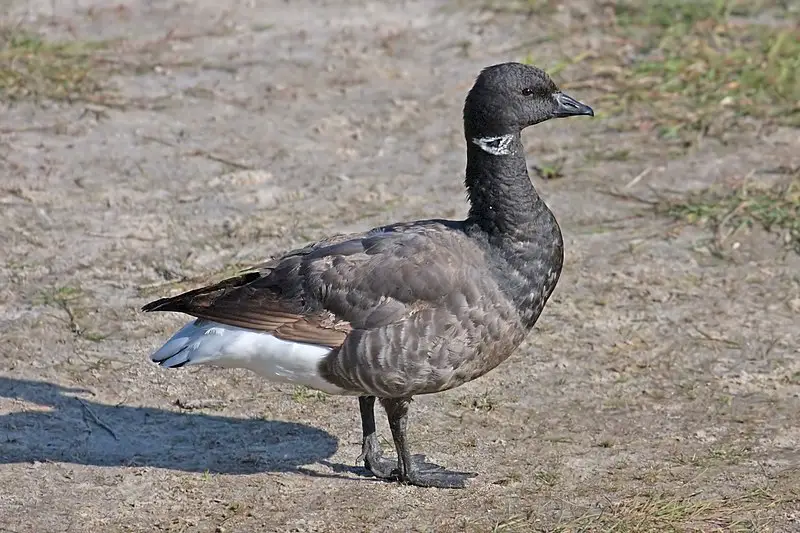
The Brent Goose, also known as the Brant or Bernicla goose, is a small species of waterfowl belonging to the genus Branta. It has three subspecies that live along temperate coastlines and breed on high-Arctic tundras.
This species can be identified by its short stubby bill, which measures between 22-26 inches long and 42-48 across their wingspan when fully grown.
They typically weigh between 0.88 – 2 lbs depending on location and seasonally changing diets they may consume while in flight or at rest stops during migration routes they take annually from one region to another.
The Brent Oilfield was named after this bird due to its abundance in certain areas near bodies of water where it would gather for safety during migrations over land formations such as mountains ranges or other geographical features that could otherwise become difficult obstacles if not avoided altogether.Scientific classification:
| Kingdom | Animalia |
| Phylum | Chordata |
| Class | Aves |
| Order | Anseriformes |
| Family | Anatidae |
| Genus | Branta |
| Species | B. bernicla |
Also Featured In: Ireland Birds, Birds that Live in Greenland
10. Cassin’s Auklet
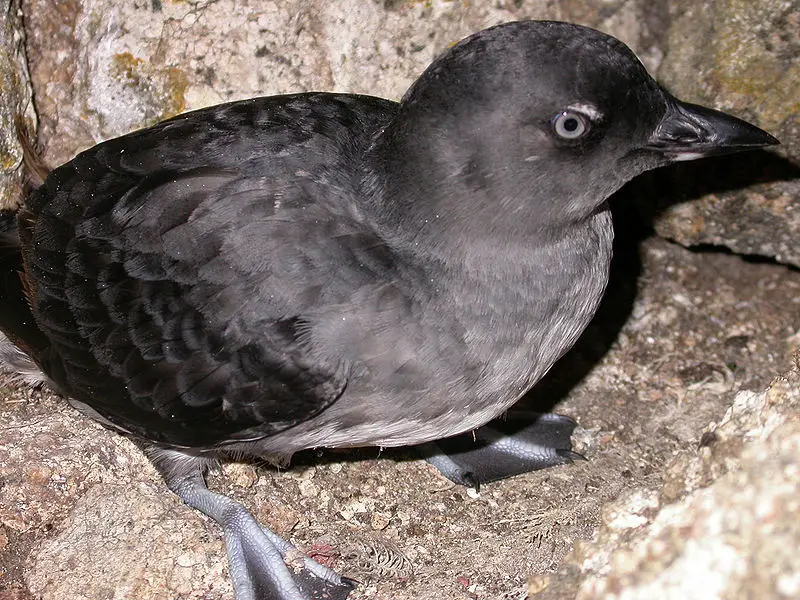
Cassin’s Auklet is a small, chunky seabird that resides in the North Pacific Ocean. It has an interesting appearance with its black head and white body.
Its wings are short and stubby which makes it difficult for them to fly long distances but they can swim quickly underwater to catch their prey.
Cassin’s Auklets nest in burrows on islands off British Columbia and California making them easily studied by researchers allowing them to be one of the better known auks.
The bird was named after American ornithologist John Cassin who first described this species back in 1858.
Today these birds continue to thrive thanks largely due to conservation efforts being made across our oceans.Scientific classification:
| Kingdom | Animalia |
| Phylum | Chordata |
| Class | Aves |
| Order | Charadriiformes |
| Family | Alcidae |
| Genus | Ptychoramphus Brandt, JF, 1837 |
| Species | P. aleuticus |
Also Featured In: Auks Species, Most Common Birds of Farallon Islands
11. Marbled Murrelet
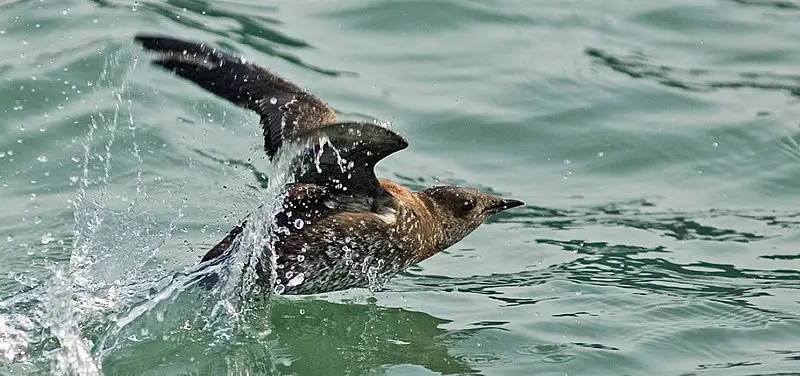
The marbled murrelet is a small seabird from the North Pacific that belongs to the auk family. It can be found nesting in old-growth forests at higher latitudes where trees cannot grow, or on the ground.
This habit of nesting was only discovered after an astute tree climber spotted a chick back in 1974 – making it one of the last birds species native to North America whose nest remained unknown until then.
With its distinctive black and white plumage, this bird stands out amongst others; yet despite being so unique, their population has been declining due to human activity over recent years.
We must act now if we are to protect these fascinating creatures for future generations.Scientific classification:
| Kingdom | Animalia |
| Phylum | Chordata |
| Class | Aves |
| Order | Charadriiformes |
| Family | Alcidae |
| Genus | Brachyramphus |
| Species | B. marmoratus |
Also Featured In: Birds that Live in San Francisco Bay Area, Birds You’ll Find in Vancouver Island
12. Black Phoebe
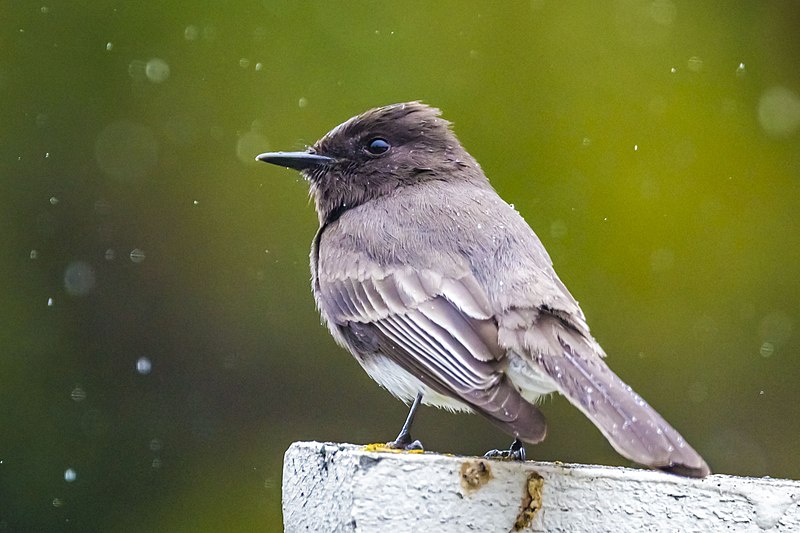
The black phoebe is a beautiful passerine bird belonging to the tyrant-flycatcher family. It breeds from southwest Oregon and California south through Central and South America, where it can be found year-round.
However, its northern populations tend to migrate seasonally in some areas. Six subspecies of this species have been identified so far: two are occasional visitors while the others are more common residents in their range.
The adult has mainly dark grey upperparts with a white belly; juveniles may show brownish tones instead of grey ones on their back.
Its main diet consists of insects which it catches by hovering over water or flying out after them from perches near rivers or streams – hence why they’re often seen around these places.Scientific classification:
| Kingdom | Animalia |
| Phylum | Chordata |
| Class | Aves |
| Order | Passeriformes |
| Family | Tyrannidae |
| Genus | Sayornis |
| Species | S. nigricans |
Also Featured In: Flycatchers Species, Birds Live Near San Diego
13. Western Gull
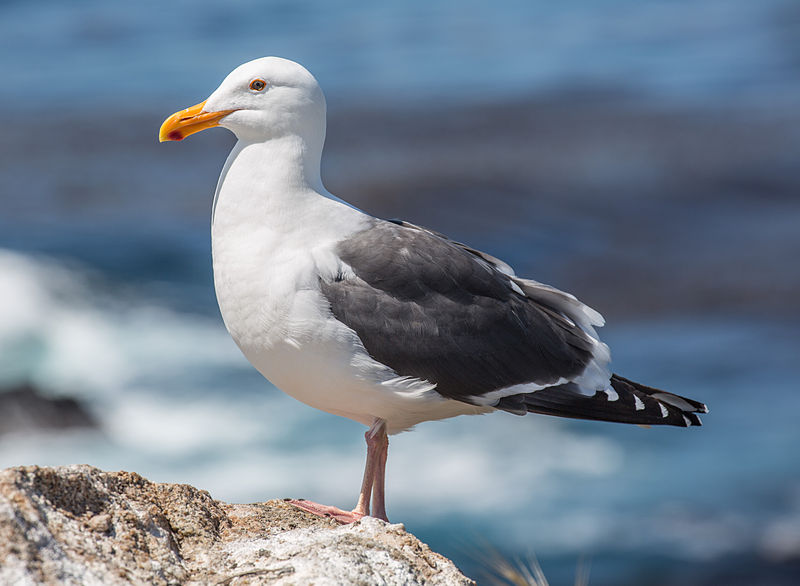
The Western Gull is a majestic seabird found on the West Coast of North America, ranging from British Columbia to Baja California. It has a large white head and stands between 22-27 inches in size.
Its upper parts are gray while its underparts range from brownish grey to white depending on age or sex of the bird.
The most distinguishing feature is its yellow feet which set it apart from other gulls in the area such as Larus livens.
These birds feed by scavenging for food including fish, mollusks, crustaceans and even carrion when available.
They also nest near ocean shores with their eggs hatching anywhere within 28 days after being laid. A beautiful sight to behold at any beach; these birds will surely captivate you with their grandeur.Scientific classification:
| Kingdom | Animalia |
| Phylum | Chordata |
| Class | Aves |
| Order | Charadriiformes |
| Family | Laridae |
| Genus | Larus |
| Species | L. occidentalis |
Also Featured In: Gulls Species, Birds that Live in the Ocean
14. Glaucous-Winged Gull
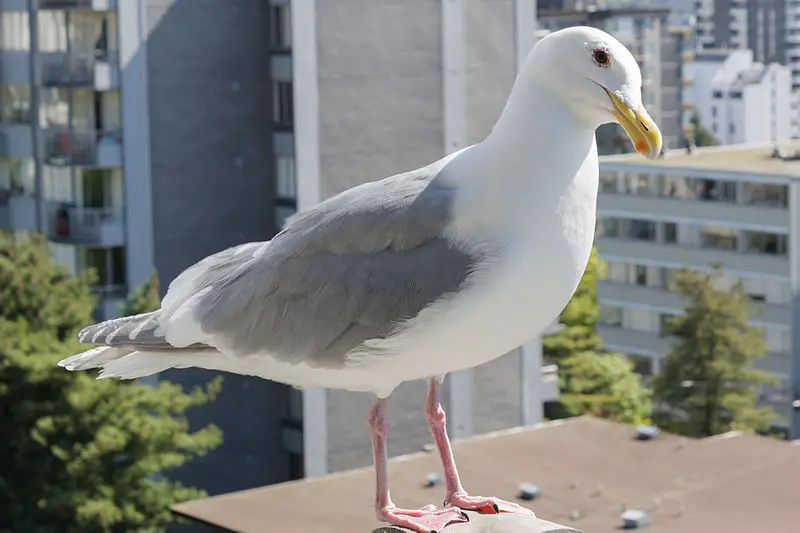
The Glaucous-winged Gull is a large white-headed bird that belongs to the Larus genus. It has grey wings, which gives it its name – glaucescens – derived from Ancient Greek and describing this coloration.
This species of gull prefers coastal areas, rarely venturing far away from the ocean’s waters. As such, they can be found in western Canada, Alaska and parts of northern Asia down through Japan into Mexico.
The Glaucous-winged Gulls are often seen scavenging for food around beaches or fishing boats as well as nesting on islands off British Columbia during summer months.
They have adapted very well to urban environments too; their intelligent nature making them quick learners when dealing with humans.Scientific classification:
| Kingdom | Animalia |
| Phylum | Chordata |
| Class | Aves |
| Order | Charadriiformes |
| Family | Laridae |
| Genus | Larus |
| Species | L. glaucescens |
Also Featured In: Birds You’ll Find in Hokkaido, Birds That Live around Gull Rock
15. Heermann’s Gull
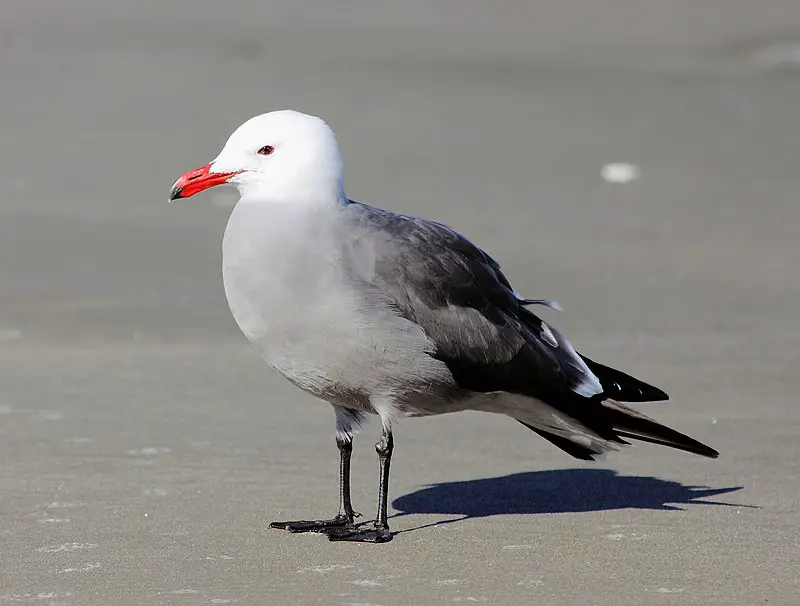
Heermann’s gull is a type of seabird found in the United States, Mexico and British Columbia. It nests on Isla Rasa in the Gulf of California and can be seen near shores or out at sea, though rarely inland.
Named after Adolphus Lewis Heermann, a nineteenth-century explorer and naturalist, this species looks quite different from other gulls due to its brownish colouring with white spots around the wings.
It has bright yellow legs as well as red eyes circled by an orange ring – features that make it easily identifiable among bird watchers.
Their diet consists mainly of fish but they will also eat insects, crustaceans and molluscs if necessary.
Although not considered endangered yet their numbers have been decreasing over time so conservation efforts are imperative for these beautiful birds.Scientific classification:
| Kingdom | Animalia |
| Phylum | Chordata |
| Class | Aves |
| Order | Charadriiformes |
| Family | Laridae |
| Genus | Larus |
| Species | L. heermanni |
16. Brandt’s Cormorant
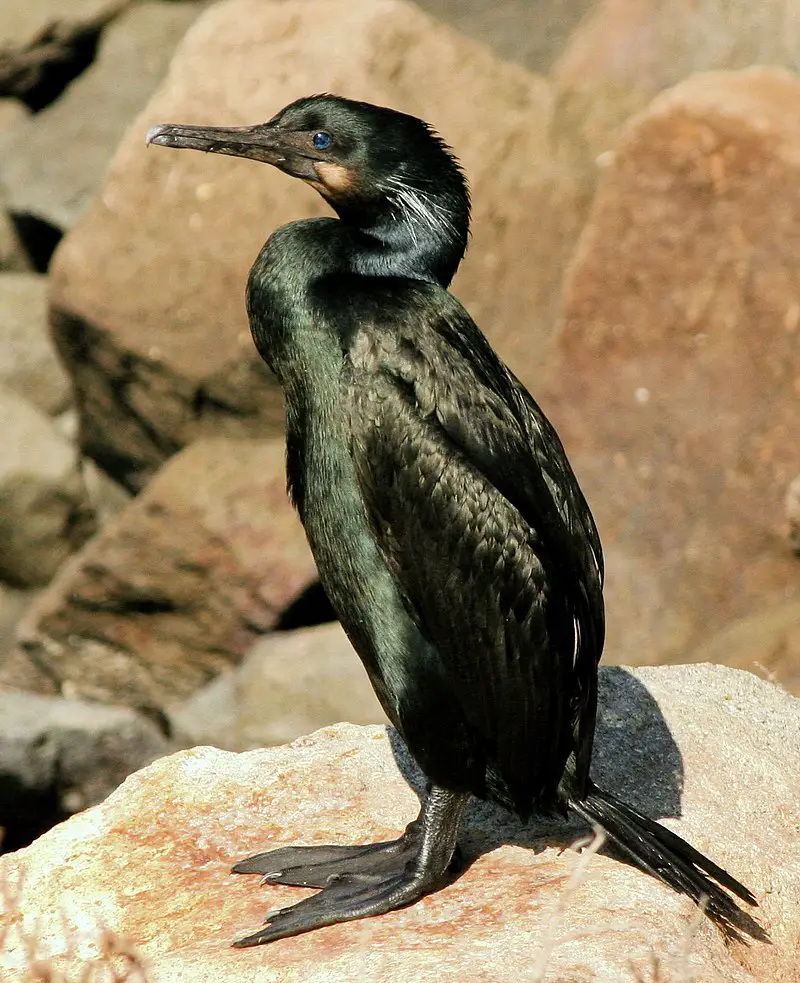
Brandt’s cormorant is a seabird of the Cormorant family that inhabits the Pacific coast of North America.
In summer, it can be found from Alaska to Gulf of California but its population northwards migrate south during winter season.
Its name Penicillatus originates from Latin which means painter’s brush referring to its white plumes on head and neck.
It feeds mainly on small fish like herring, anchovy etc., diving up to 30 m deep for food catch in cold water near shorelines or at sea around offshore islands or continental shelfs.
They breed along rocky shoresline building nests out of seaweed and sticks close together in colonies numbering into hundreds while producing two eggs per year with incubation period lasting 25-35 days before chicks fledge after seven weeks post hatching.
Brandt’s cormorants are considered an important species as they help maintain balance between marine predators and prey by controlling populations through their diet habits .Scientific classification:
| Kingdom | Animalia |
| Phylum | Chordata |
| Class | Aves |
| Order | Suliformes |
| Family | Phalacrocoracidae |
| Genus | Urile |
| Species | U. penicillatus |
Also Featured In: Cormorant Species, Birds You’ll Find in the Sea
17. California Condor
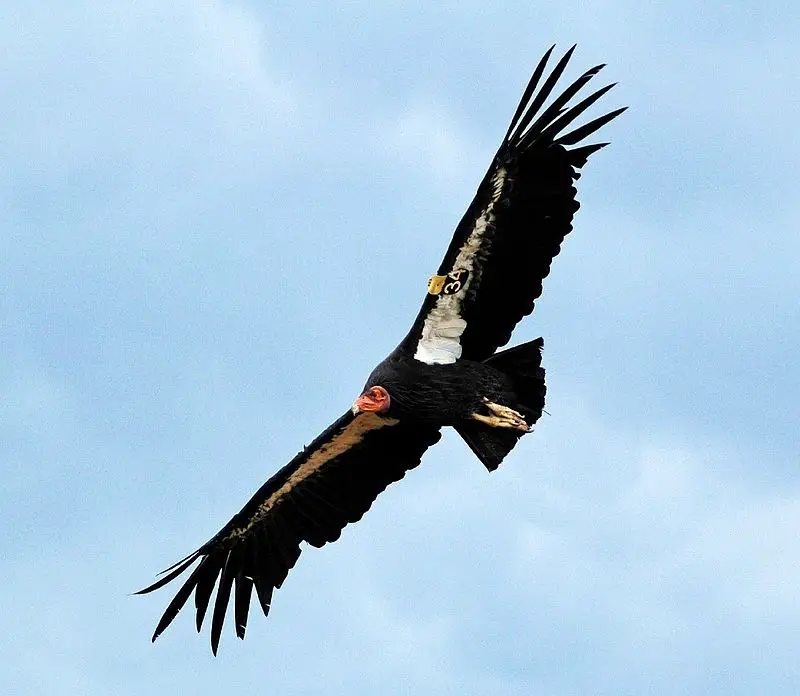
The California condor is a majestic bird, being the largest North American landbird. It was sadly pushed to extinction in the wild back in 1987 when all remaining individuals were captured.
Since then, conservation efforts have allowed for reintroductions of these birds into areas such as northern Arizona and southern Utah, including Zion National Park and Grand Canyon area; coastal mountains of California; and northern Baja California.
The species has been given plenty of protection with numerous laws created to protect it from human interference or disturbance while also helping boost its population size through captive breeding programs.
Thanks to this effort we can now enjoy seeing this incredible species flying across our skies once more.Scientific classification:
| Kingdom | Animalia |
| Phylum | Chordata |
| Class | Aves |
| Order | Accipitriformes |
| Family | Cathartidae |
| Genus | Gymnogyps |
| Species | G. californianus |
Also Featured In: Common Californian Birds, Birds You’ll Find in Zoo
18. Western Tanager
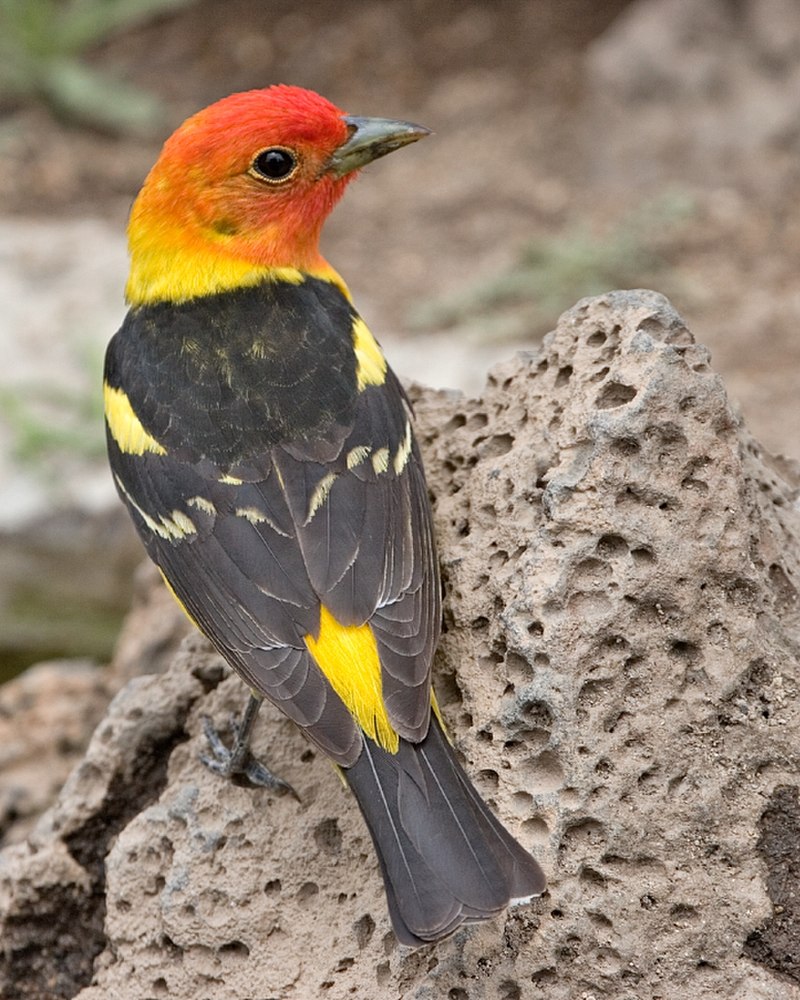
The Western Tanager (Piranga ludoviciana) is a medium-sized songbird belonging to the cardinal family, Cardinalidae. It was illustrated and formally described by American ornithologist Alexander Wilson in 1811.
The species has distinctive plumage including yellow feathers on its wings and tail, red shoulders, black head with white forehead patch and grayish underparts.
Its vocalizations are also very similar to other members of the cardinal family – they have a high pitched ‘tsee’ note followed by several sweeter notes that come together as parts of complex songs.
They primarily feed on fruit but will also take insects when available for extra protein during breeding season.
These beautiful birds can be found throughout western North America from Alaska down through Mexico making them an iconic part of many landscapes.Scientific classification:
| Kingdom | Animalia |
| Phylum | Chordata |
| Class | Aves |
| Order | Passeriformes |
| Family | Cardinalidae |
| Genus | Piranga |
| Species | P. ludoviciana |
Also Featured In: Utah Birds, Birds that Found in the Yellowstone
19. Willet
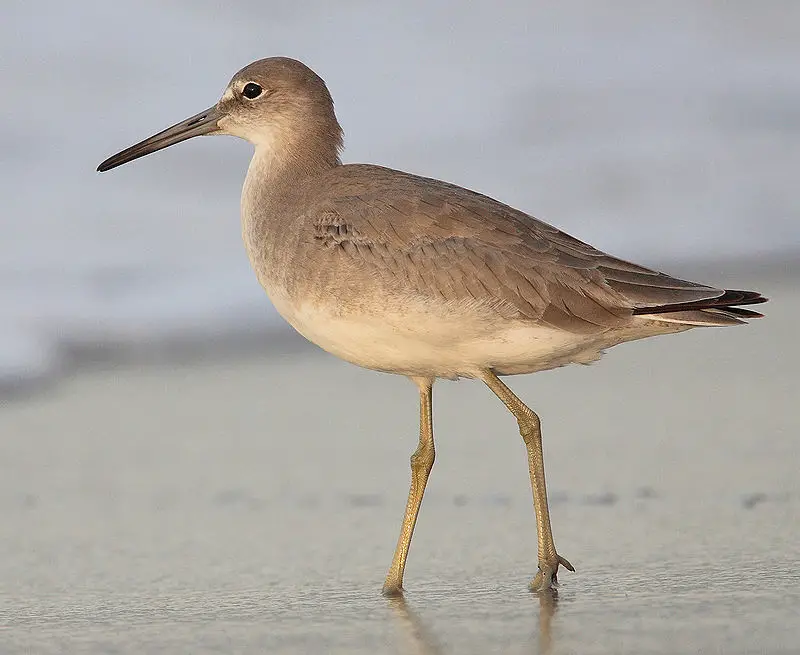
The Willet is a large and robust bird of the Scolopacidae family. It belongs to genus Tringa and it is much larger than its closest relative – lesser yellowlegs, which can be easily distinguished by its fine neck pattern.
The willet has brown upperparts with white patches on wings along with grey underparts. Its bill is thick, long and straight in shape having black coloration at tip while legs are also long but greenish-grey in colour.
They feed mainly on insects, worms or crustaceans that they find near coastal waters or wetlands as well as grains or seeds when available during winters.Scientific classification:
| Kingdom | Animalia |
| Phylum | Chordata |
| Class | Aves |
| Order | Charadriiformes |
| Family | Scolopacidae |
| Genus | Tringa |
| Species | T. semipalmata |
Also Featured In: birds of Delaware, Birds that can be Seen in Outer Banks
20. Hooded Oriole
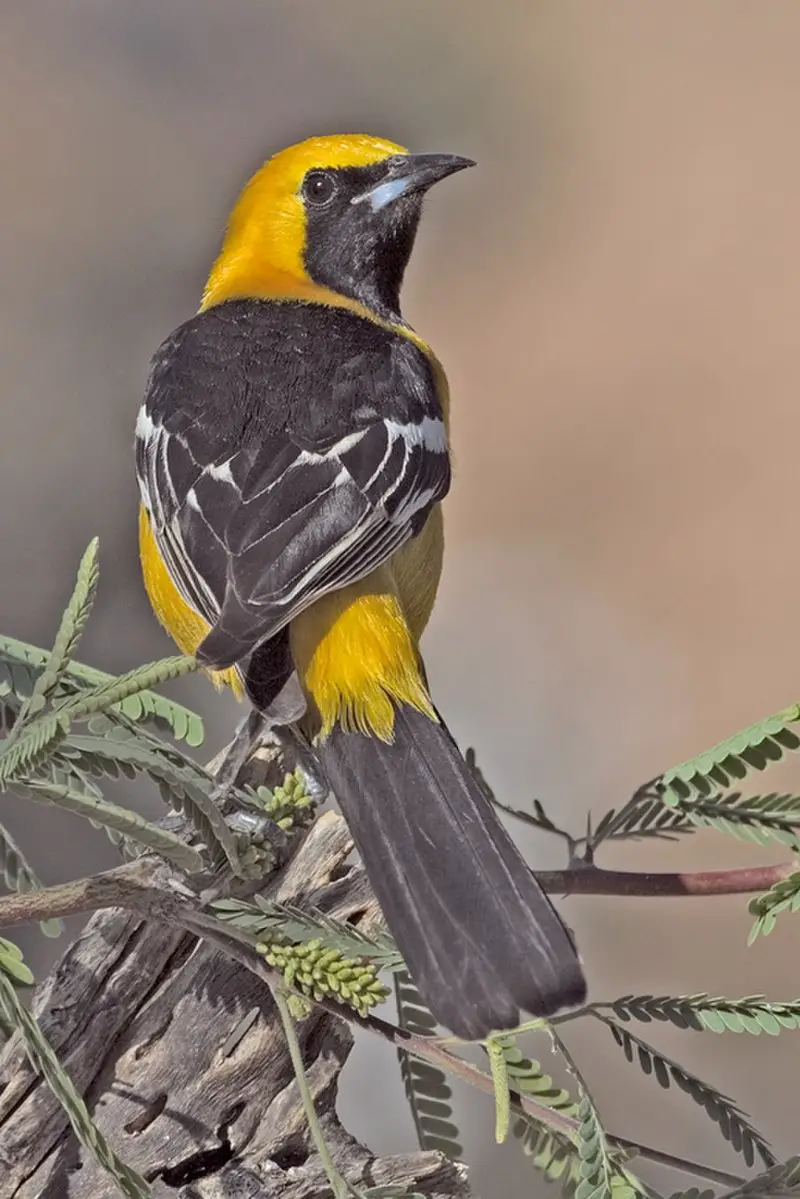
The Hooded Oriole is a medium-sized New World bird with bright, vibrant colours. The male has an orange to yellow body and black back, face, tail and bib.
Its wings have two white bars that stand out against the dark feathers surrounding it. The female is more of an olive colouration but also shows some yellow accents too.
Both sexes have a curved bill which is completely black in colour as well as having white wing bars on its wings for easy identification from other birds in the area.
It typically lives in open woodlands or tropical areas where there are plenty of trees providing food sources such as insects and fruit for them to eat while they perch amongst their branches during nesting season.Scientific classification:
| Kingdom | Animalia |
| Phylum | Chordata |
| Class | Aves |
| Order | Passeriformes |
| Family | Icteridae |
| Genus | Icterus |
| Species | I. cucullatus |
Also Featured In: birds of Arizona, Birds You’ll Find in South Texas
21. Long-Billed Curlew
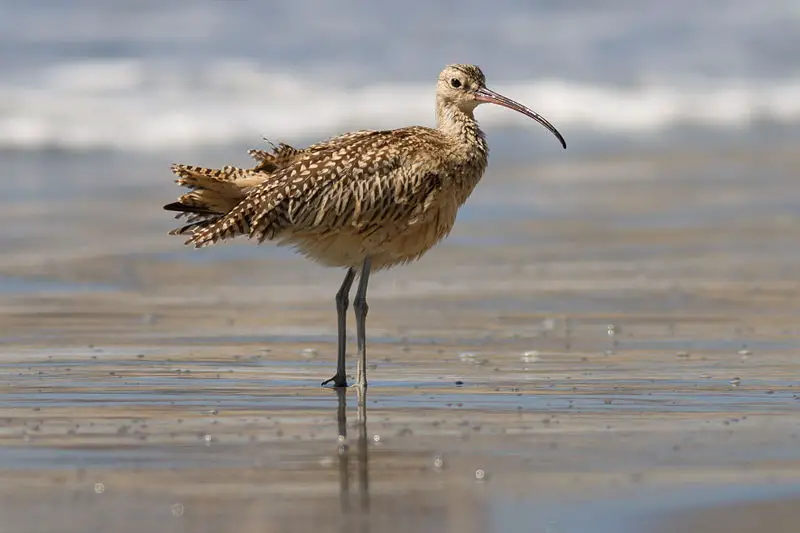
The Long-billed Curlew is an impressive shorebird, 50 to 65 cm in length and boasting a bill that can be up to 10cm long – hence its name
This species breeds in the central and western areas of North America before migrating south for winter.
Its distinctive call has earned it nicknames like “sickle bird” or “candlestick bird”. They are omnivorous, eating insects, spiders as well as plants both on land and in the water.
In addition they also have been known to scavenge carrion from time to time.
These magnificent birds inhabit coastal regions such as mudflats, marshes and beaches making them easy enough spot if you know their habitat.Scientific classification:
| Kingdom | Animalia |
| Phylum | Chordata |
| Class | Aves |
| Order | Charadriiformes |
| Family | Scolopacidae |
| Genus | Numenius |
| Species | N. americanus |
Also Featured In: birds of Idaho, Birds that Live in the Grasslands
22. Cinnamon Teal
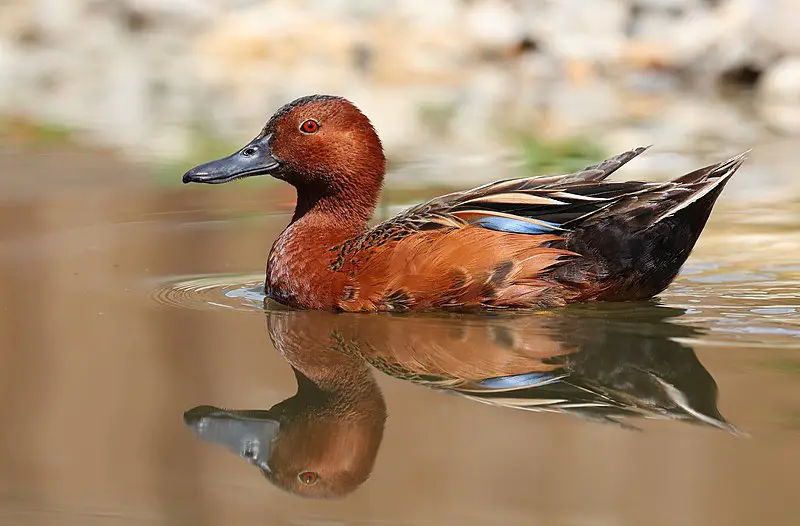
The Cinnamon Teal is a species of duck found in western North and South America. The males are bright reddish-brown while the female’s plumage is duller brown.
They inhabit marshes and ponds, feasting on plants–mainly seeds, roots, stems and leaves. Both genders have dark bills but it’s the male that stands out with its cinnamon-red head & body as well as red eye.
For nesting they prefer areas near shallow water where there are plenty of aquatic vegetation – often making their nests among grasses or cattails to conceal themselves from predators like foxes & raccoons.
These impressive birds also migrate during springtime; travelling far distances across open waters between continents – an incredible feat for such small creatures.Scientific classification:
| Kingdom | Animalia |
| Phylum | Chordata |
| Class | Aves |
| Order | Anseriformes |
| Family | Anatidae |
| Genus | Spatula |
| Species | S. cyanoptera |
Also Featured In: birds of Wyoming, Most Common Lake Birds
23. Western Sandpiper
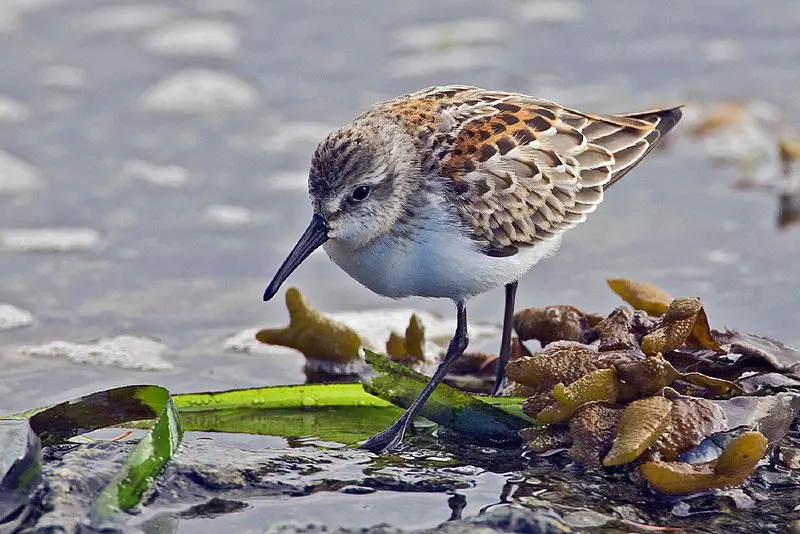
The Western sandpiper is a small shorebird found in North America. Its genus name, Kalidris, comes from the Ancient Greek term used by Aristotle for some grey-colored waterside birds.
The species name, mauri, is named after Italian botanist Ernesto Mauri. This species is one of the most abundant shorebirds in North America, with a population in the millions. Western sandpipers have dark legs and a short, straight bill.
They are often seen running quickly along the shorelines, probing the sand for insects and small crustaceans.
During breeding season, they nest in the Arctic tundra, and during migration, they can be found on mudflats and beaches along the Pacific Coast as well as inland shallow freshwater wetlands.Scientific classification:
| Kingdom | Animalia |
| Phylum | Chordata |
| Class | Aves |
| Order | Charadriiformes |
| Family | Scolopacidae |
| Genus | Calidris |
| Species | C. mauri |
Also Featured In: Estuaries Birds, Birds in Pacific Northwest
24. Surf Scoter
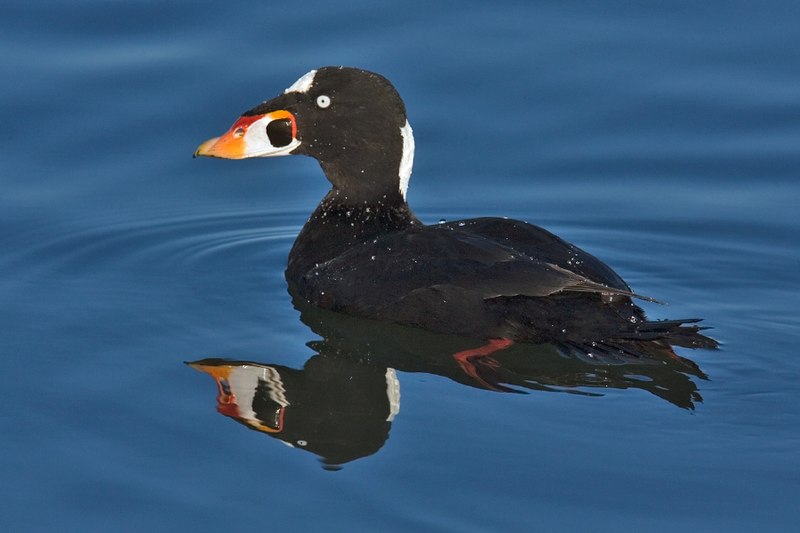
The surf scoter is a fascinating bird species that can be found along the coasts of North America. Adult males have a unique appearance with mostly black feathers and white patches on their forehead and nape.
Female surf scoters are slightly smaller and have a browner plumage. These sea ducks typically breed in Northern Canada and Alaska before migrating to wintering grounds along the Atlantic and Pacific coasts.
Surf scoters are diving birds that feed primarily on benthic invertebrates such as clams and crabs.
Due to habitat loss and hunting, the surf scoter population has declined in recent years, making conservation efforts crucial for the survival of this beautiful bird species.
Overall, the surf scoter is an important part of the North American ecosystem and a fascinating bird to observe in the wild.Scientific classification:
| Kingdom | Animalia |
| Phylum | Chordata |
| Class | Aves |
| Order | Anseriformes |
| Family | Anatidae |
| Genus | Melanitta |
| Subgenus | Melanitta |
| Species | M. perspicillata |
Also Featured In: Native Birds Of Winter Island,